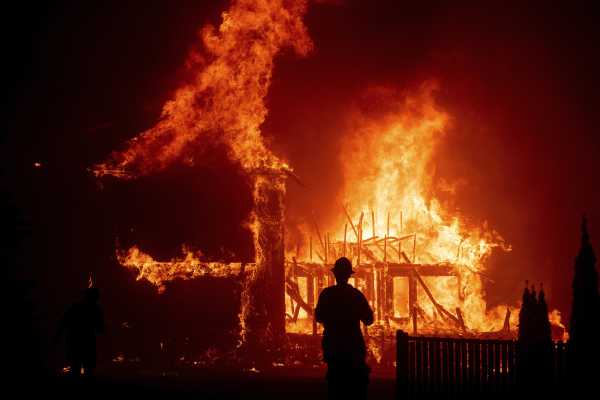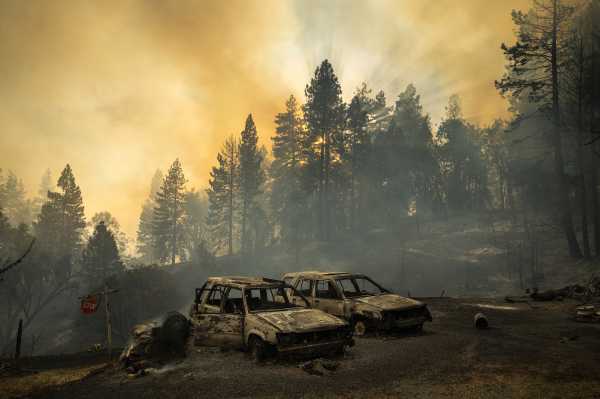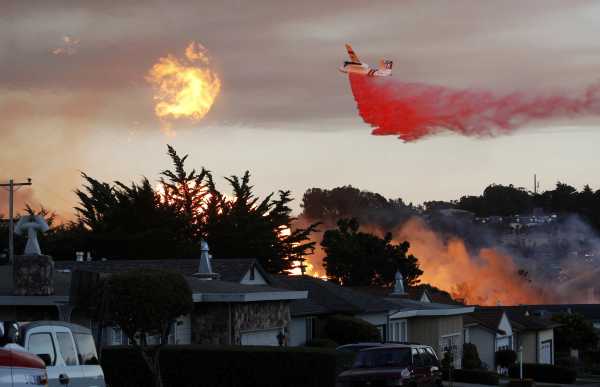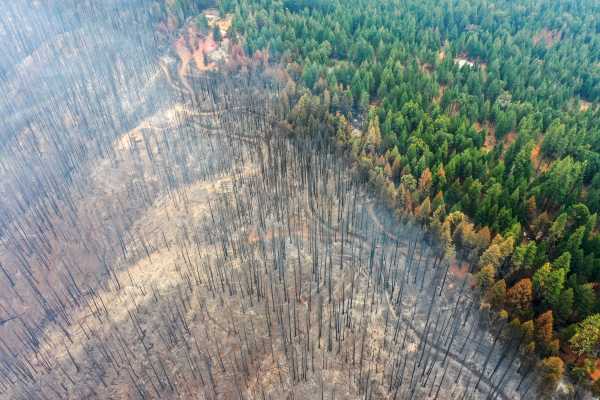
California’s weeks-long heat wave finally broke over the weekend. But the state is still battling the Mosquito Fire in the foothills east of Sacramento. Investigators have not determined the exact cause of the fire, though it started near a power line operated by Pacific Gas & Electric (PG&E), one of the largest utilities in the country.
These events echo some of what happened in the summer of 2018. California was facing its hottest summer then on record when PG&E power lines sparked the Camp Fire. The fire found plenty of fuel in the hot, dry season to level the town of Paradise and led to at least 85 deaths. PG&E ultimately pled guilty to 84 counts of involuntary manslaughter and one felony.
Wall Street Journal reporter Katherine Blunt and her colleagues were finalists for a 2020 Pulitzer Prize for their reporting throughout the crisis. Her new book, California Burning, is an even more thorough chronicle of the many failures of PG&E to invest in an outdated grid for its 16 million customers.
I spoke to her about the lessons her reporting contains, not just for PG&E and California, but for utilities and customers everywhere in the changed climate. Our interview has been edited for length and clarity.
Wildfire season has become longer and more destructive because of the warming climate. Downed power lines are going to keep sparking fires, and those fires are worse because it’s so dry. Still, it’s not always clear where the line is between manmade disaster and natural disaster. How do you draw that line?
Over the last 10 years the risk profile of PG&E’s service territory changed very quickly, as a result of severe drought that killed millions of trees. So the consequence of a spark from a power line all of a sudden has much more devastating potential than it had historically. The fire faces greater risk of spreading quickly out of control, as we’ve seen with the fires that have destroyed large parts of Northern California.
Power lines inherently have the potential to cause fires. If it’s a small blaze, it’s easy to contain in a day or two. Or, does it spread to become something like the Camp Fire on the other end of the extreme? The climate factor and environmental changes have really added to the severity of the challenges that the company faces in trying to mitigate fire risk and address the threats that its power lines may pose.
It’s like being trapped in this endless cycle. PG&E has a plan to bury a lot of power lines in the next decade. Will that really help?
The company historically has argued that burying power lines would be too expensive. They have changed their tune within the last year after the Dixie Fire of July 2021, which ignited when a tree touched a power line in the Feather River Canyon — the second largest fire in California history. After that, they came out with a new strategy to bury 10,000 miles of distribution wire, and it has the potential to really help mitigate risk. If the wire’s underground, it can’t start a fire, but it is still substantially expensive because the company estimates the cost to be $20 billion.
There are also critics who have questioned whether the undergrounding needs to be done at that scale, because there’s other things PG&E could do to insulate wires from sparking if they come into contact with trees. It’ll be up to state regulators to scrutinize whether this is the most appropriate plan. In theory, it could really do a lot to reduce risk if they are able to pull it off and do so without burdening consumers too much.
If we do find out a PG&E line is also responsible for the Mosquito Fire, is there anything different about how PG&E handled its response now compared to what it would have done before the Camp Fire?
If there’s any good takeaways from this story, it is that PG&E has never been more aware of the risk, and it’s never worked harder to try to address it. They’re doing much more by way of inspection and maintenance than they had prior to some of the devastating fires. There’s no question about that.

But the flip side of that is a level of risk inherent throughout the system. There’s always the potential for a tree branch or heavy winds to come into contact with a wire. There’s the risk for some sort of mechanical failure of a tower or pole that ultimately drops the live wire. One thing the company has been doing lately is that if an object or a tree branch comes into contact with a line that’s in an area of high risk of fire, it shuts off immediately. They have seen a reduction in ignitions, but the consequence of that is customers in some areas are experiencing much more frequent power outages.
The Mosquito Fire’s final cause is yet to be determined. But if there’s indications PG&E may have started it, it only serves to underscore the fact that some risk is inherent.
Even if a utility like PG&E gets better at warding off wildfires, they are still preemptively cutting consumers off from power. Is that why there’s been so much worry over rolling blackouts?
It’s a different issue. In California, all the utilities have, in recent years, begun to use what’s known as the public safety power shut-off. And that is a preemptive shut-off when wildfire risk seems especially high. They have been deploying this strategy quite often when the winds pick up and make it increase the likelihood of either a power line failure, or a tree branch coming into contact with a live wire. The company is also trying to do more [like trimming trees and wire maintenance] so that it won’t have to do that as often. But it’s going to be a number of years before the company doesn’t have to lean on that tool as often.
How is that different from the widespread blackouts California narrowly avoided last week?
If you hear “rolling blackouts” that’s meant specifically to keep levels of electricity supply and demand in balance. It’s a different issue. The grid is calibrated in a way that if demand threatens to exceed supply, you have the potential for widespread system failure, and it’s a really complicated and lengthy process to fix it. So that’s when you see the grid operator, in this case, the California Independent System Operator, monitoring levels of supply and demand when it’s really hot and everyone’s using electricity, and making sure that demand doesn’t exceed supply.
Supply has been tight lately for a number of reasons. Hydroelectric power has been constrained as a result of the drought. When we see these more intense Western heat waves, California has less potential to import power on an emergency basis because other states are also using a lot of electricity. And we’re seeing supply chain issues slow or delay the development of certain clean energy projects; each of the utilities are trying hard to bring on new generation and clean generation, specifically wind, solar, and battery projects.
Medium and long term, California and other regions can work through some of these challenges, but it’s also widely expected that these next few summers are going to be difficult because of those supply constraints.
Utilities are about to get billions of dollars in funding through the new Inflation Reduction Act, so I wonder where you think this story is headed.
One big focus of the Inflation Reduction Act is it attempts to speed the development of clean energy projects, which has been slowed for a number of reasons over the last year or so. That has the potential to ease some of the supply constraints we’re seeing in California and other places. Other results of the bill may be funding for basic investment in existing assets, making them more resilient, maybe improving their capacity, maybe improving their safety.
All of this is to say that spending on the health of the grid across the country is becoming increasingly important, as we see more climate risks and as we move into a future in which we will be more reliant on electricity. So I am watching how utilities across the country manage the spending on both clean energy and preparing the grid for the future of demand.
What reporting surprised you most?
I was surprised at some of the parallels between the circumstances that led to a large pipeline explosion in 2010 south of San Francisco, when a PG&E gas transmission pipeline exploded in the middle of a neighborhood, and the 2018 Camp Fire when a transmission line failed. There were stronger parallels there than I thought. And I think understanding those parallels helps understand the roots of the problems this company has faced over time.

One issue that is important to understand: Utilities make money on large capital investments that boost the overall value of their systems. They do not make money on day-to-day operations and maintenance expenses like inspections and tiny replacements here and there. And, in each case, the divisions overseeing gas transmission and electric transmission were under pressure to cut expenses, and ultimately cut expenses to the point where they weren’t doing enough to evaluate the risks throughout the system.
PG&E is the nation’s largest investor-owned utility and your book chronicles over and over again how executives overlooked maintenance. So for investor-owned utilities, is there something maybe inherently in the model that’s too focused on returning profit and cost-cutting?
Absolutely. A publicly owned utility does not have a profit motive, whereas an investor-owned utility does have a profit motive. And the argument there is that profit motive allows the company greater capital, but there can be inherent tension between private interests in delivering for shareholders and the public good. By way of maintaining the safety of the system, theoretically, a company can strike this balance. But over the last 20 years or so, PG&E did not strike this balance very well. And it’s far from the only utility that has been challenged in that way. I think it’s important to acknowledge and understand that dynamic as we evaluate the risks facing other utilities across the country.
One thing that’s kind of frightening is that with PG&E and other utilities across the country, it has often taken disaster to reveal the extent of the problem and results in some sort of system overhaul that better prioritizes safety.
I wonder how these kinds of lessons might be relevant outside California.
Think about Hurricane Ida, which flew through Louisiana last fall and knocked out all the transmission lines serving New Orleans. Stronger storms have resulted in longer and more significant power outages because of grid failure. And there have been places like Minnesota dealing with a substantial fire risk last summer. In the case of Texas’s deep freeze, one of the problems was that these plant owners didn’t invest in their plants to run at sub-freezing temperatures, because Texas historically has rarely experienced freezing temperatures.
The power grid is aging across the country. A lot of the components date back to World War II, if not prior to that. Coupled with the fact that we are seeing more extreme weather events exacerbated by climate change, utilities across the country are having to grapple with a new set of risks. How do you bolster the system to account for what, in some ways, is kind of the unknown? The past is not the same predictor of the future that it used to be. A lot of utilities across the country rely on backward-looking data and modeling to try to understand what’s going to be coming down the pike. And that’s not as useful as it once was.
I think PG&E is a cautionary tale of what happens when a utility is asked to confront new risks, and it has a general history of mismanaging risk and mismanaging spending. It only becomes more challenging, and the failure only becomes more consequential.

PG&E recommended your book as required reading for employees. That’s pretty surprising since this is holding them to account. What do you think they’d learn from reading it?
One thing that was evident to me, reporting this book, is understanding it’s a story of systemic failure.
Some of these disasters were the result of incremental decision-making over the course of years. It becomes nearly impossible to pinpoint one decision or one individual who made decisions leading to the disasters that we’ve seen over the last couple of decades. It is an enormous company in which employees are often focused on a singular task; focused on keeping trees away from power lines or on doing inspections of a certain type of equipment.
I can only hope that that knowledge helps those who might not have had the opportunity to get a bigger-picture understanding. Maybe they’ll have a better idea of how their individual decisions fit within this broader system and how their decisions can really help keep the system functioning or contribute to failure depending on the circumstances.
There’s this theme of failure in foresight.
It’s not easy. How do you prepare? How do you evaluate future risk? Historically, past risk has been used to evaluate potential future risk. And if that relationship is breaking down, how you address it is not an easy proposition.
Will you support Vox’s explanatory journalism?
Millions turn to Vox to understand what’s happening in the news. Our mission has never been more vital than it is in this moment: to empower through understanding. Financial contributions from our readers are a critical part of supporting our resource-intensive work and help us keep our journalism free for all. Please consider making a contribution to Vox today.
Sourse: vox.com






